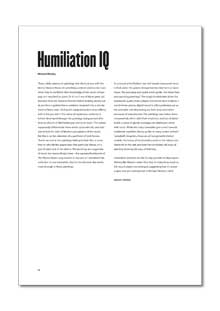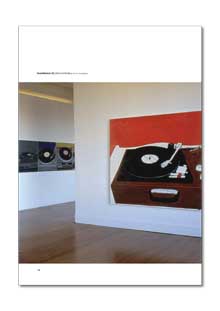 |
|||||||||
|
|
| ...Publications: Annual | ...The Physics Room Annual 2004 | |||||||||||||
|
Humiliation IQ. These coldly austere oil paintings look down at you with the kind of disdain those 20-something pretend-adolescents have when they’re confident their knowledge of the canon of subpop isn’t matched by yours. Or it’s as if one of those great old bastards from the National Portrait Gallery looking sternly out at you from a golden frame suddenly morphed into a circular sheet of black vinyl. And you’re supposed to feel some affinity with it. But you don’t. This sense of mysterious authority is further developed through the paintings being named after famous albums of alternative pop and punk music. The names supposedly differentiate these works systematically and lead one to look for clues of Morley’s perceptions of the music. But this is no fan adulation of a pantheon of rock heroes. There’s no clue in the paintings linking to their title, or as to how or why Morley appreciates that particular album. It’s a specification lost in the silence. The paintings are suggestive of music but resoundingly silent - the squeaky floorboards of The Physics Room sang loudest in my ears as I wandered this collection of vast turntables. And it’s this absence that works most strongly in these paintings. As a sound artist Morley’s raw and loosely-structured music is filed under the genres of experimental, free form or noise music. The post-pop, post-punk avant-garde. Are these then post-painting paintings? The rough brushstrokes share the handmade quality that a played instrument does today in a world where precise digital sound is often preferred, just as the turntable and oil painting are both now outmoded processes of reproduction. The paintings’ size makes them monumental, which with their emptiness and lack of detail builds a sense of gentle nostalgia, lost afternoons alone with music. While the many turntables give a nod towards modernist repetition, lining up like so many screen-printed Campbell’s Soup tins, these are all recognisably distinct models. The heavy oil brushstrokes point to the labour and handcraft in the task and date the turntables: old ways of painting showing old ways of listening. Somewhat sidelined are the brushy portraits of skyscrapers. Waving like Monet’s water-lilies they’re reduced as much as the record players are enlarged, suggesting that it’s soundscapes that are monumental in Michael Morley’s mind. Alastair Crawford View Humiliation IQ. Essay by Alistair Crawford as a PDF This essay originally appeared in The Physics Room Annual 2004 Order your copy today from The Physics Room ! Related 8 June - 3 July, 2004
|
|||||||||||||


